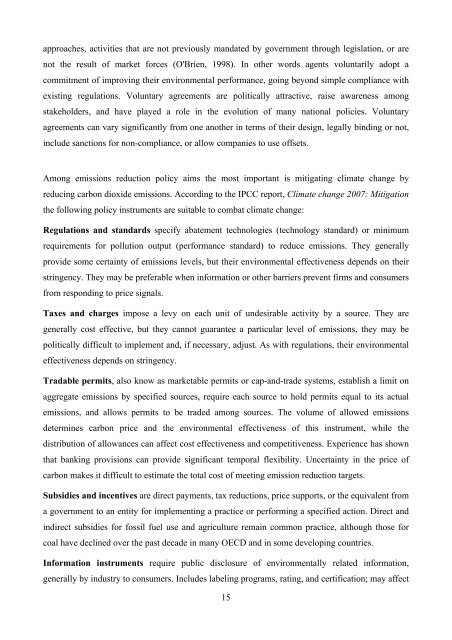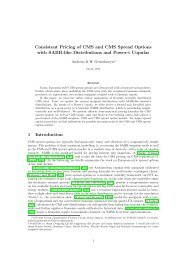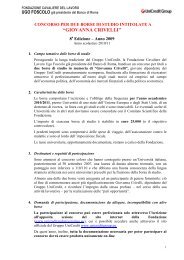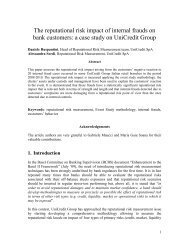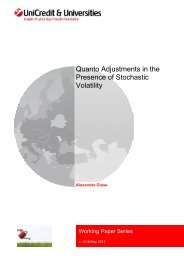Dóra Fazekas Carbon Market Implications for new EU - UniCredit ...
Dóra Fazekas Carbon Market Implications for new EU - UniCredit ...
Dóra Fazekas Carbon Market Implications for new EU - UniCredit ...
You also want an ePaper? Increase the reach of your titles
YUMPU automatically turns print PDFs into web optimized ePapers that Google loves.
approaches, activities that are not previously mandated by government through legislation, or are<br />
not the result of market <strong>for</strong>ces (O'Brien, 1998). In other words agents voluntarily adopt a<br />
commitment of improving their environmental per<strong>for</strong>mance, going beyond simple compliance with<br />
existing regulations. Voluntary agreements are politically attractive, raise awareness among<br />
stakeholders, and have played a role in the evolution of many national policies. Voluntary<br />
agreements can vary significantly from one another in terms of their design, legally binding or not,<br />
include sanctions <strong>for</strong> non-compliance, or allow companies to use offsets.<br />
Among emissions reduction policy aims the most important is mitigating climate change by<br />
reducing carbon dioxide emissions. According to the IPCC report, Climate change 2007: Mitigation<br />
the following policy instruments are suitable to combat climate change:<br />
Regulations and standards specify abatement technologies (technology standard) or minimum<br />
requirements <strong>for</strong> pollution output (per<strong>for</strong>mance standard) to reduce emissions. They generally<br />
provide some certainty of emissions levels, but their environmental effectiveness depends on their<br />
stringency. They may be preferable when in<strong>for</strong>mation or other barriers prevent firms and consumers<br />
from responding to price signals.<br />
Taxes and charges impose a levy on each unit of undesirable activity by a source. They are<br />
generally cost effective, but they cannot guarantee a particular level of emissions, they may be<br />
politically difficult to implement and, if necessary, adjust. As with regulations, their environmental<br />
effectiveness depends on stringency.<br />
Tradable permits, also know as marketable permits or cap-and-trade systems, establish a limit on<br />
aggregate emissions by specified sources, require each source to hold permits equal to its actual<br />
emissions, and allows permits to be traded among sources. The volume of allowed emissions<br />
determines carbon price and the environmental effectiveness of this instrument, while the<br />
distribution of allowances can affect cost effectiveness and competitiveness. Experience has shown<br />
that banking provisions can provide significant temporal flexibility. Uncertainty in the price of<br />
carbon makes it difficult to estimate the total cost of meeting emission reduction targets.<br />
Subsidies and incentives are direct payments, tax reductions, price supports, or the equivalent from<br />
a government to an entity <strong>for</strong> implementing a practice or per<strong>for</strong>ming a specified action. Direct and<br />
indirect subsidies <strong>for</strong> fossil fuel use and agriculture remain common practice, although those <strong>for</strong><br />
coal have declined over the past decade in many OECD and in some developing countries.<br />
In<strong>for</strong>mation instruments require public disclosure of environmentally related in<strong>for</strong>mation,<br />
generally by industry to consumers. Includes labeling programs, rating, and certification; may affect<br />
15


